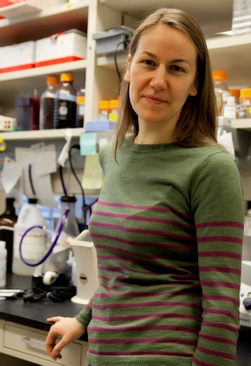
Tiny regulators produced by a cancer-causing virus may be the intermediaries in a sequence leading to the most common malignancy in HIV-infected people.
Investigating Kaposi’s Sarcoma-associated herpesvirus (KSHV), Eva Gottwein, PhD, assistant professor in microbiology-immunology, focuses on the interaction of KSHV microRNAs (miRNAs) and the genes they repress.
KSHV represents an important model system for cancer research as it is one of just seven human cancer viruses. But how it causes cancer is still not well understood. What is known is that KSHV produces small regulators – miRNAs – which could lead infected cells to acquire cancerous properties.
“MicroRNAs function by repressing the activity of specific genes and consequently altering cellular properties,” said Gottwein, a member of the Robert H. Lurie Comprehensive Cancer Center of Northwestern University. “Our objective is to understand the contribution of the KSHV miRNAs to KSHV-induced cancers. To reach this goal, it is critical to identify which genes are being repressed.”
KSHV causes two types of cancer in immuno-compromised individuals – Kaposi’s sarcoma (KS) and B cell lymphoma. Disproportionally affecting people with AIDS, KS is the most common AIDS-associated cancer and has become one of the most common cancers in Africa. Gottwein’s primary objective is to develop an initial understanding of the targets and functions of the viral miRNAs expressed in KSHV-infected cells.
“We believe this research will lead to critical insights into the biology of Kaposi’s sarcoma and a better understanding of how miRNAs in general can contribute to carcinogenesis. Interestingly, KSHV produces several miRNAs that mimic miRNAs naturally present in human cells,” Gottwein said. “It is particularly important to understand the function of these viral miRNAs, because their naturally occurring equivalents are known or suspected to be involved in the development of other cancers.”
Because each miRNAs can repress hundreds of genetic targets, figuring out how they select them and which are important is a complex task.
In 2011, Gottwein published research that identified the genes repressed by KSHV miRNAs in cells derived from KSHV-associated B-cell lymphomas. She is now working to identify the important target genes of KSHV miRNAs that may play a role in the progression of Kaposi’s sarcoma.
Using an American Cancer Society, Illinois Division grant, Gottwein’s lab continues to investigate the interaction of KSHV miRNAs with a focus on the most promising genes being repressed.






